Previous issues
- Page Path
- HOME > Articles and issues > Previous issues
Editorial
- How to transform the medical care system after the COVID-19 pandemic
- Jong-Koo Lee
- Osong Public Health Res Perspect. 2023;14(6):439-440. Published online December 28, 2023
- DOI: https://doi.org/10.24171/j.phrp.2023.0382
- 611 View
- 152 Download
Review Article
- Global prevalence of enterobiasis in young children over the past 20 years: a systematic review and meta-analysis
- Elham Kia Lashaki, Azadeh Mizani, Seyed Abdollah Hosseini, Bentolhoda Habibi, Khadijeh Taherkhani, Amir Javadi, AliReza Taremiha, Samira Dodangeh
- Osong Public Health Res Perspect. 2023;14(6):441-450. Published online December 28, 2023
- DOI: https://doi.org/10.24171/j.phrp.2023.0204
- 982 View
- 54 Download
-
 Graphical Abstract
Graphical Abstract
 Abstract
Abstract
 PDF
PDF 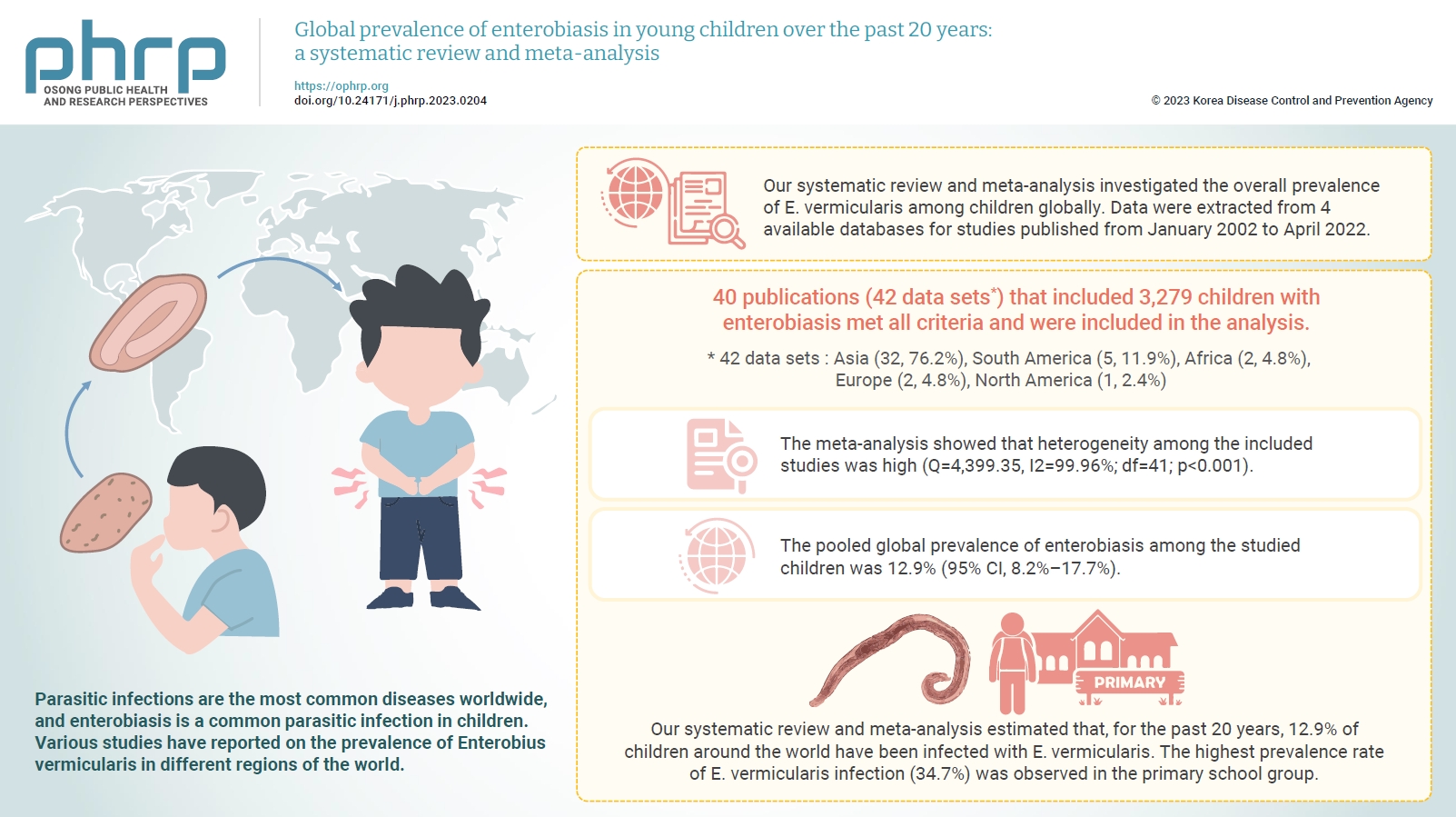
- Parasitic infections are the most common diseases worldwide, and enterobiasis is a common parasitic infection in children. Various studies have reported on the prevalence of Enterobius vermicularis in different regions of the world. However, no study has gathered and analyzed this data systematically. Our systematic review and meta-analysis investigated the overall prevalence of E. vermicularis among children globally. Data were extracted from 4 available databases for studies published from January 2002 to April 2022. The quality of the included studies was scored based on the standard Strengthening the Reporting of Observational Studies in Epidemiology. A random-effect model was chosen to calculate the pooled prevalence and corresponding 95% confidence interval (CI) according to the degree of heterogeneity in the included studies. Thus, 40 publications (42 data sets) that included 3,279 children with enterobiasis met all criteria and were included in the analysis. The meta-analysis showed that heterogeneity among the included studies was high (Q=4,399.35, I2=99.96%; df=41; p<0.001). The pooled global prevalence of enterobiasis among the studied children was 12.9% (95% CI, 8.2%–17.7%). Our systematic review and meta-analysis estimated that, for the past 20 years, 12.9% of children around the world have been infected with E. vermicularis.
Original Articles
- The value of CDC42 effector protein 2 as a novel prognostic biomarker in liver hepatocellular carcinoma: a comprehensive data analysis
- Hye-Ran Kim, Choong Won Seo, Jongwan Kim
- Osong Public Health Res Perspect. 2023;14(6):451-467. Published online December 15, 2023
- DOI: https://doi.org/10.24171/j.phrp.2023.0229
- 858 View
- 38 Download
-
 Graphical Abstract
Graphical Abstract
 Abstract
Abstract
 PDF
PDF 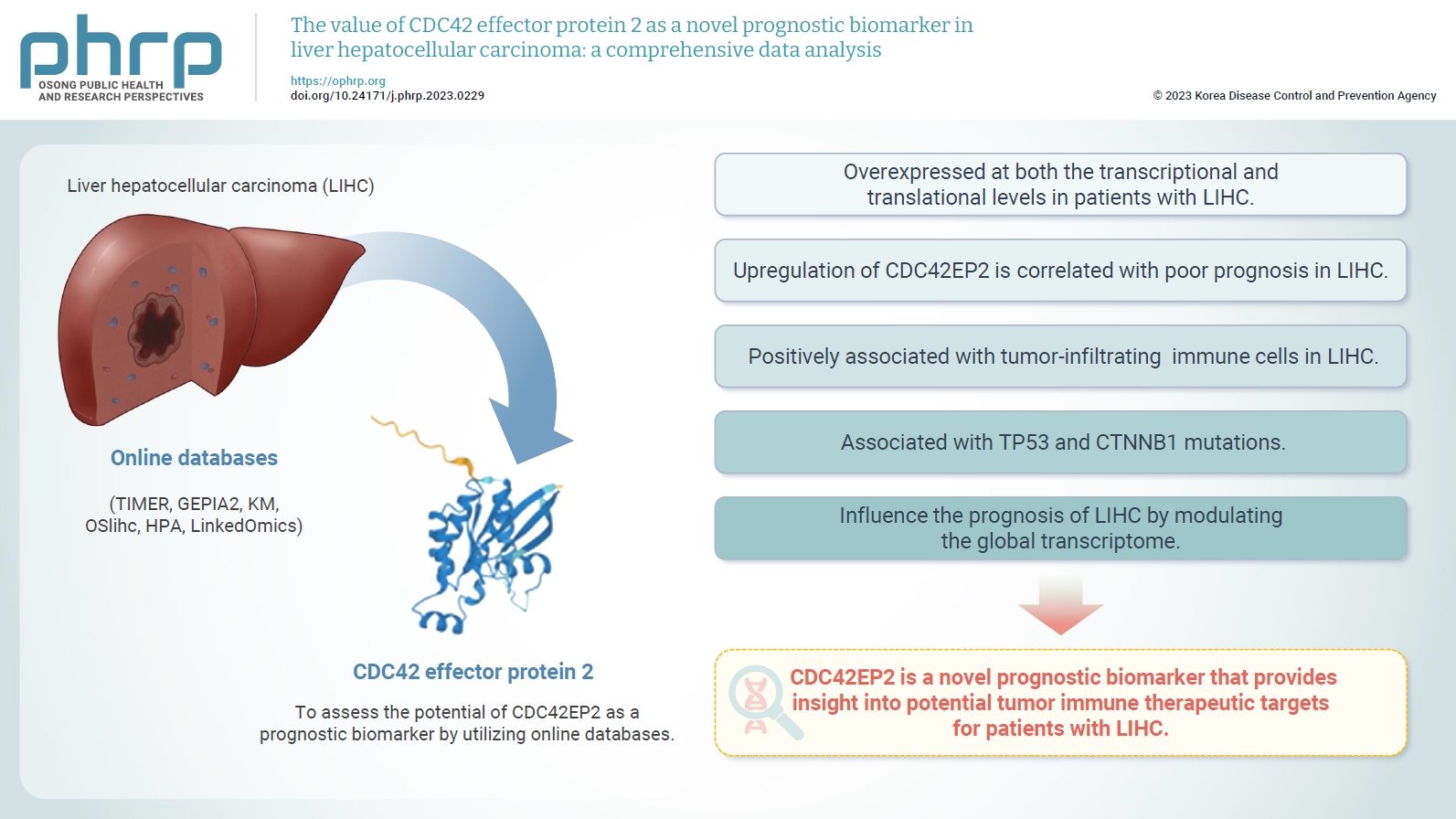
- Objectives
The prognostic significance of CDC42 effector protein 2 (CDC42EP2) and its association with tumor-infiltrating immune cells (TIICs) have not been explored in liver hepatocellular carcinoma (LIHC). This study aims to assess the potential prognostic value of CDC42EP2 by conducting a comprehensive analysis of online databases pertaining to LIHC. Methods: We evaluated the potential of CDC42EP2 as a prognostic biomarker by utilizing online databases such as TIMER, GEPIA2, KM, OSlihc, HPA, and LinkedOmics. Results: In LIHC, we observed that the mRNA and protein expression of CDC42EP2 were upregulated compared to normal tissues. Upregulated CDC42EP2 expression was associated with a worse prognosis based on the clinicopathological characteristics of patients with LIHC. Furthermore, CDC42EP2 was positively associated with TIICs. In the co-expression and functional enrichment analyses of CDC42EP2, 11,416 genes showed positive associations with CDC42EP2 while 8,008 genes showed negative associations. CDC42EP2-related co-expression genes were involved in protein localization to the endoplasmic reticulum, translational initiation, and RNA catabolic processes in gene set enrichment analysis-Gene Ontology (GSEAGO), and regulated the ribosome, spliceosome, and primary immune deficiency in the GSEAKyoto Encyclopedia of Genes and Genomes (KEGG) pathway. In a survival map, 23 and 17 genes that exhibited positive associations with CDC42EP2 showed a significant hazard ratio (HR) for overall survival and disease-free survival, respectively. Conclusion: Our findings demonstrated that CDC42EP2 is a novel prognostic biomarker and a potential tumor immune therapeutic target in patients with LIHC.
- The effect of the COVID-19 pandemic on the trends and characteristics of natural and unnatural deaths in an urban Sri Lankan cohort viewed through retrospective analysis of forensic death investigations from 2019 to 2022
- Sameera Anuruddha Gunawardena, Nishani Dassanayake, Buddhika Indeewarie Keerawelle, Shivasankarie Kanthasamy, Hasini Ranganatha, Jayani Wathsala Gunawardana
- Osong Public Health Res Perspect. 2023;14(6):468-482. Published online November 23, 2023
- DOI: https://doi.org/10.24171/j.phrp.2023.0175
- 1,172 View
- 45 Download
-
 Graphical Abstract
Graphical Abstract
 Abstract
Abstract
 PDF
PDF 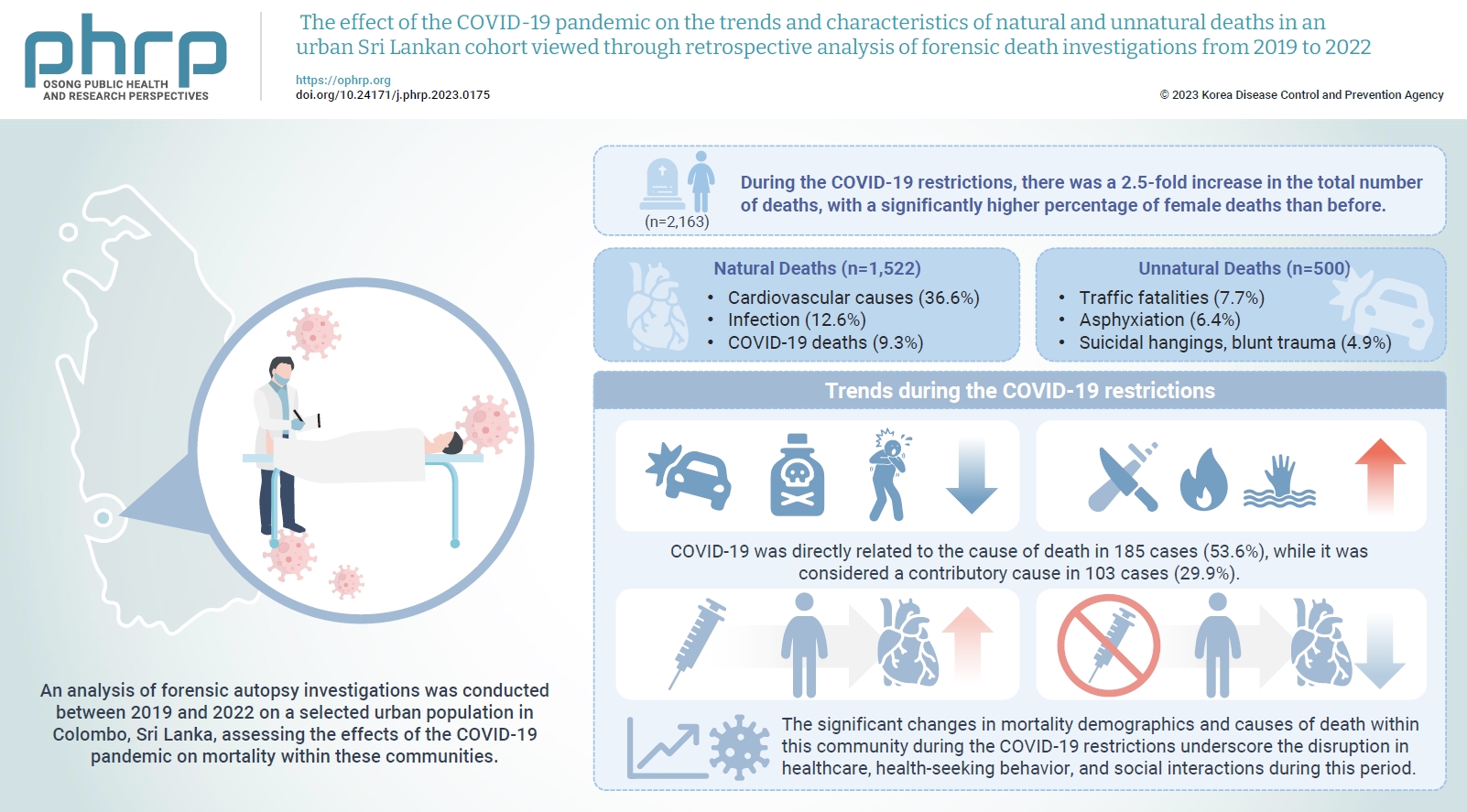
- Objectives
The coronavirus disease 2019 (COVID-19) pandemic has had a severe impact on global health. Apart from the disease itself, the strict restrictions and lockdowns enforced to minimize its spread have also substantially disrupted personal and public health. Methods: An analysis of forensic autopsy investigations was conducted between 2019 and 2022 on a selected urban population in Colombo, Sri Lanka, assessing the effects of the COVID-19 pandemic on mortality within these communities. Results: During the COVID-19 restrictions, there was a 2.5-fold increase in the total number of deaths, with a significantly higher percentage of female deaths than before. The majority of these deaths were due to cardiovascular causes, while COVID-19-related deaths ranked third overall. The highest proportion of COVID-19 deaths occurred among unvaccinated females. The monthly frequency of deaths from traffic accidents, poisoning, and asphyxiation decreased, while deaths from blunt trauma, sharp trauma, burns, and immersion increased. There was also a rise in blunt homicides and a greater number of femicides during the COVID-19 restrictions than in the pre-pandemic period. A significantly higher percentage of males who received the COVID-19 vaccine died from cardiovascular causes compared to those in the unvaccinated group. Conclusion: The significant changes in mortality demographics and causes of death within this community during the COVID-19 restrictions underscore the disruption in healthcare, healthseeking behavior, and social interactions during this period. The vulnerability of individuals residing in highly urbanized areas with lower socioeconomic status, particularly women, is brought into sharp focus.
- Characteristics and related factors of waterborne and foodborne infectious disease outbreaks before and after the onset of the COVID-19 pandemic (2017–2021) in the Republic of Korea: a descriptive study
- Eunkyoung Kim, Bryan Inho Kim
- Osong Public Health Res Perspect. 2023;14(6):483-493. Published online December 14, 2023
- DOI: https://doi.org/10.24171/j.phrp.2023.0221
- 795 View
- 43 Download
-
 Graphical Abstract
Graphical Abstract
 Abstract
Abstract
 PDF
PDF 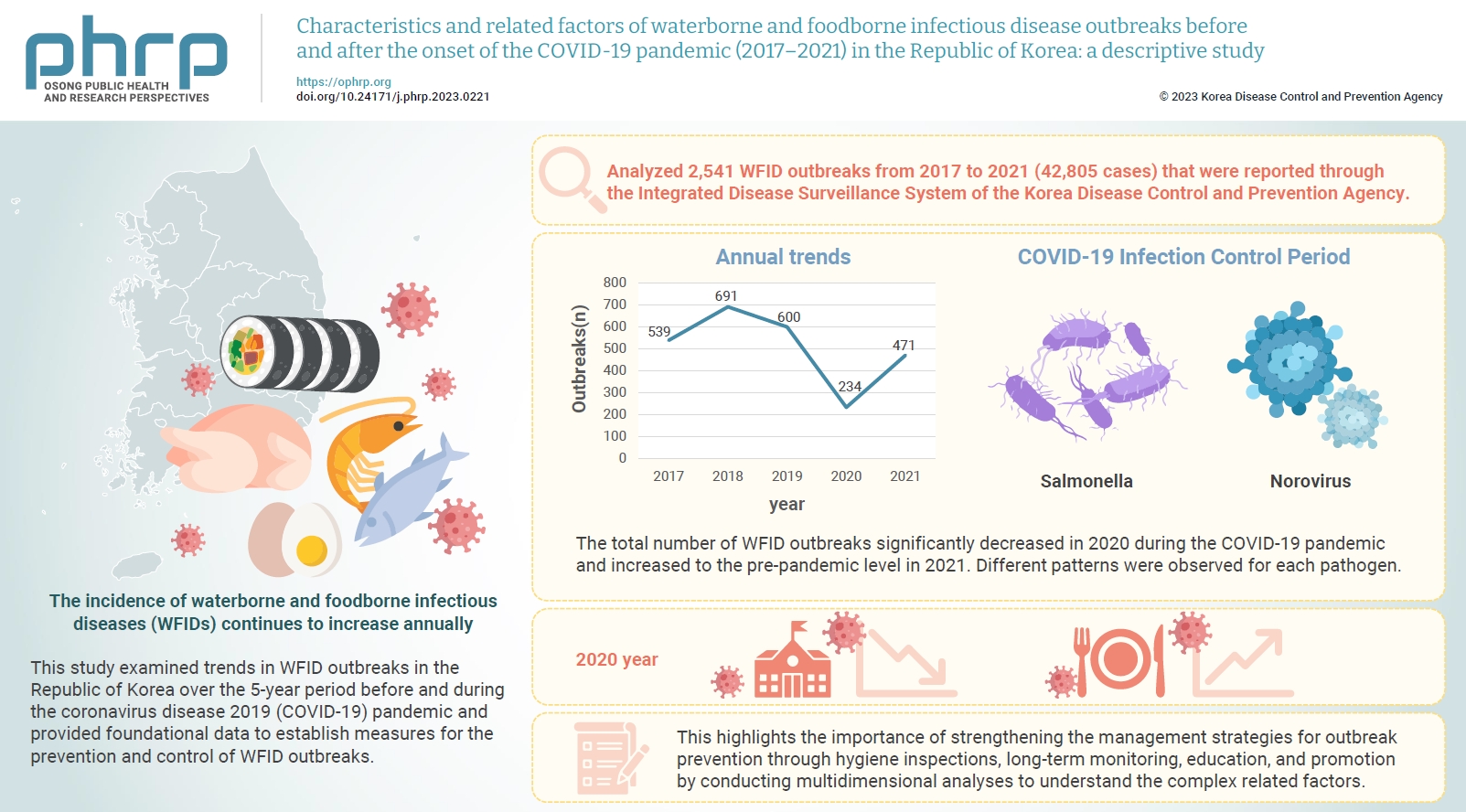
- Objectives
The incidence of waterborne and foodborne infectious diseases (WFIDs) continues to increase annually, attracting significant global attention. This study examined trends in WFID outbreaks in the Republic of Korea over the 5-year period before and during the coronavirus disease 2019 (COVID-19) pandemic and provided foundational data to establish measures for the prevention and control of WFID outbreaks. Methods: We analyzed 2,541 WFID outbreaks from 2017 to 2021 (42,805 cases) that were reported through the Integrated Disease Surveillance System of the Korea Disease Control and Prevention Agency. Outbreaks were defined as the occurrence of gastrointestinal symptoms in ≥2 individuals within a group with temporal and regional epidemiological associations. The related factors associated with WFID outbreaks during the observation period were statistically analyzed. Results: The total number of WFID outbreaks significantly decreased in 2020 during the COVID-19 pandemic and increased to the pre-pandemic level in 2021. Different patterns were observed for each pathogen. The incidence of Salmonella outbreaks more than doubled, while norovirus outbreaks decreased significantly. Conclusion: WFID outbreaks in the Republic of Korea showed different patterns before and during the COVID-19 pandemic, influenced by infection control measures and changes in dietary consumption patterns. Outbreaks of some diseases increased, but the infection control measures applied during the pandemic resulted in a significant decrease in the overall number of WFID outbreaks. This highlights the importance of strengthening the management strategies for outbreak prevention through hygiene inspections, long-term monitoring, education, and promotion by conducting multidimensional analyses to understand the complex related factors.
- Genetic diversity and evolutionary patterns of SARS-CoV-2 among the Bhutanese population during the pandemic
- Tshering Dorji, Kunzang Dorji, Tandin Wangchuk, Tshering Pelki, Sonam Gyeltshen
- Osong Public Health Res Perspect. 2023;14(6):494-507. Published online December 14, 2023
- DOI: https://doi.org/10.24171/j.phrp.2023.0209
- 1,165 View
- 48 Download
-
 Graphical Abstract
Graphical Abstract
 Abstract
Abstract
 PDF
PDF 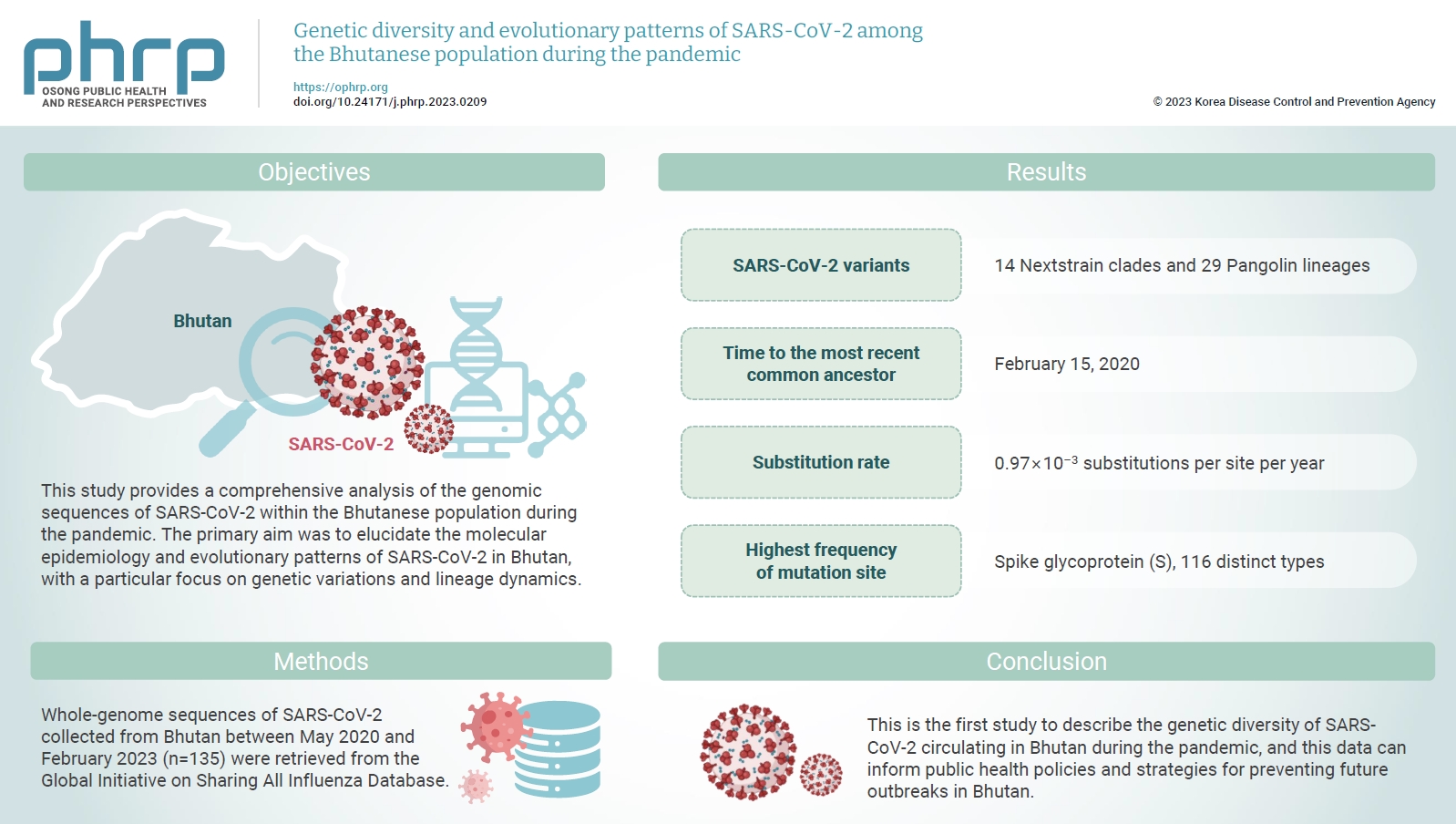
- Objectives
The coronavirus disease 2019 (COVID-19) pandemic, caused by a dynamic virus, has had a profound global impact. Despite declining global COVID-19 cases and mortality rates, the emergence of new severe acute respiratory syndrome coronavirus 2 (SARS-CoV-2) variants remains a major concern. This study provides a comprehensive analysis of the genomic sequences of SARS-CoV-2 within the Bhutanese population during the pandemic. The primary aim was to elucidate the molecular epidemiology and evolutionary patterns of SARS-CoV-2 in Bhutan, with a particular focus on genetic variations and lineage dynamics. Methods: Whole-genome sequences of SARS-CoV-2 collected from Bhutan between May 2020 and February 2023 (n=135) were retrieved from the Global Initiative on Sharing All Influenza Database. Results: The SARS-CoV-2 variants in Bhutan were predominantly classified within the Nextstrain clade 20A (31.1%), followed by clade 21L (20%) and clade 22D (15.6%). We identified 26 Pangolin lineages with variations in their spatial and temporal distribution. Bayesian time-scaled phylogenetic analysis estimated the time to the most recent common ancestor as February 15, 2020, with a substitution rate of 0.97×10–3 substitutions per site per year. Notably, the spike glycoprotein displayed the highest mutation frequency among major viral proteins, with 116 distinct mutations, including D614G. The Bhutanese isolates also featured mutations such as E484K, K417N, and S477N in the spike protein, which have implications for altered viral properties. Conclusion: This is the first study to describe the genetic diversity of SARS-CoV-2 circulating in Bhutan during the pandemic, and this data can inform public health policies and strategies for preventing future outbreaks in Bhutan.
- Estimation of the onset time of diabetic complications in type 2 diabetes patients in Thailand: a survival analysis
- Natthanicha Sauenram, Jutatip Sillabutra, Chukiat Viwatwongkasem, Pratana Satitvipawee
- Osong Public Health Res Perspect. 2023;14(6):508-519. Published online November 23, 2023
- DOI: https://doi.org/10.24171/j.phrp.2023.0084
- 1,069 View
- 61 Download
-
 Graphical Abstract
Graphical Abstract
 Abstract
Abstract
 PDF
PDF 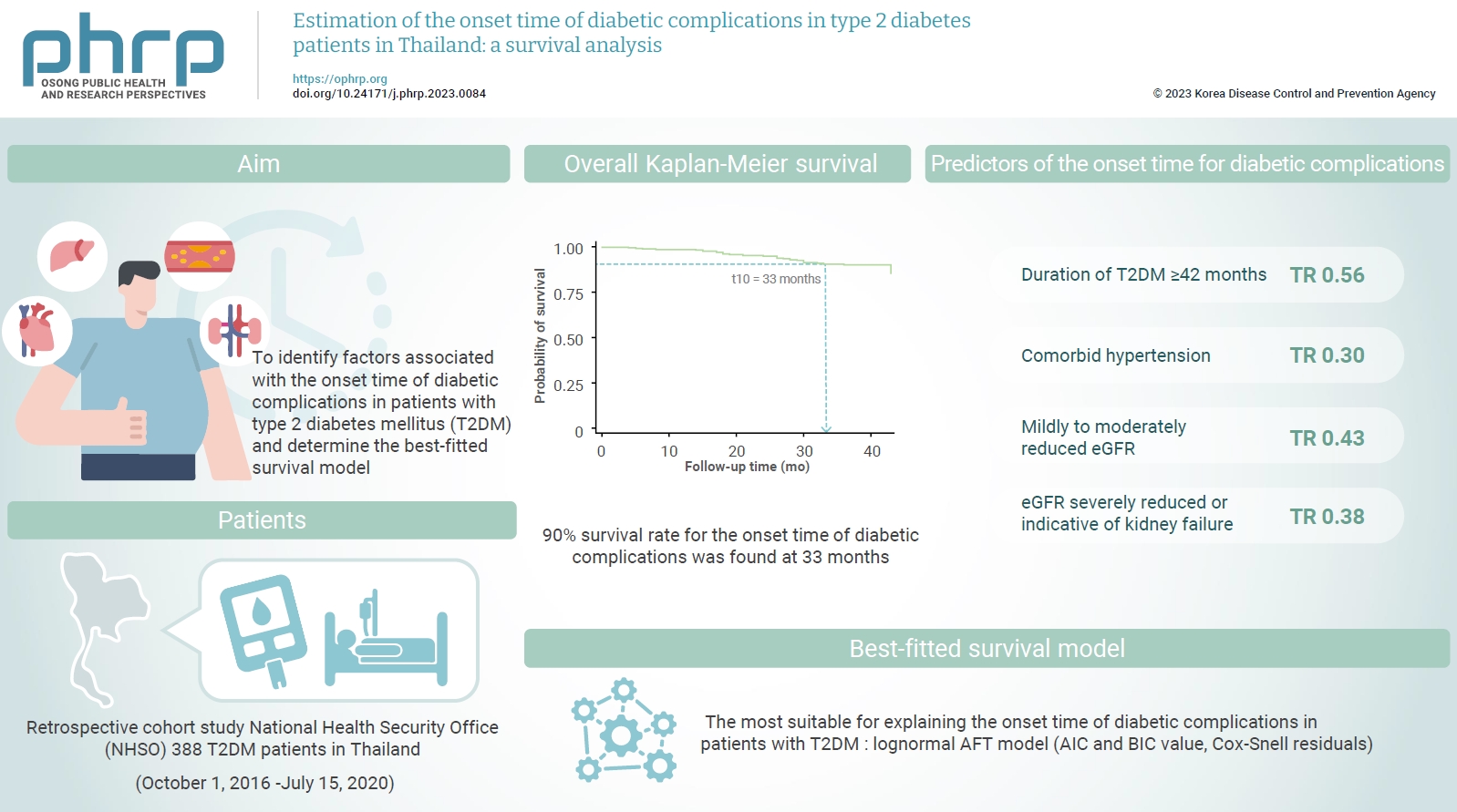
- Objectives
This study aimed to identify factors associated with the onset time of diabetic complications in patients with type 2 diabetes mellitus (T2DM) and determine the best-fitted survival model. Methods: A retrospective cohort study was conducted among T2DM patients enrolled from October 1, 2016 to July 15, 2020 at the National Health Security Office (NHSO). In total, 388 T2DM patients were included. Cox proportional-hazard and parametric models were used to identify factors related to the onset time of diabetic complications. The Akaike information criterion, Bayesian information criterion, and Cox-Snell residual were compared to determine the best-fitted survival model. Results: Thirty diabetic complication events were detected among the 388 patients (7.7%). A 90% survival rate for the onset time of diabetic complications was found at 33 months after the first T2DM diagnosis. According to multivariate analysis, a duration of T2DM ≥42 months (time ratio [TR], 0.56; 95% confidence interval [CI], 0.33–0.96; p=0.034), comorbid hypertension (TR, 0.30; 95% CI, 0.15–0.60; p=0.001), mildly to moderately reduced levels of the estimated glomerular filtration rate (eGFR) (TR, 0.43; 95% CI, 0.24–0.75; p=0.003) and an eGFR that was severely reduced or indicative of kidney failure (TR, 0.38; 95% CI, 0.16–0.88; p=0.025) were significantly associated with the onset time of diabetic complications (p<0.05). Conclusion: Patients with T2DM durations of more than 42 months, comorbid hypertension, and decreased eGFR were at risk of developing diabetic complications. The NHSO should be aware of these factors to establish a policy to prevent diabetic complications after the diagnosis of T2DM.
- Factors affecting depression and health-related quality of life in the elderly during the COVID-19 pandemic
- Deok-Ju Kim
- Osong Public Health Res Perspect. 2023;14(6):520-529. Published online November 16, 2023
- DOI: https://doi.org/10.24171/j.phrp.2023.0166
- 860 View
- 42 Download
-
 Graphical Abstract
Graphical Abstract
 Abstract
Abstract
 PDF
PDF 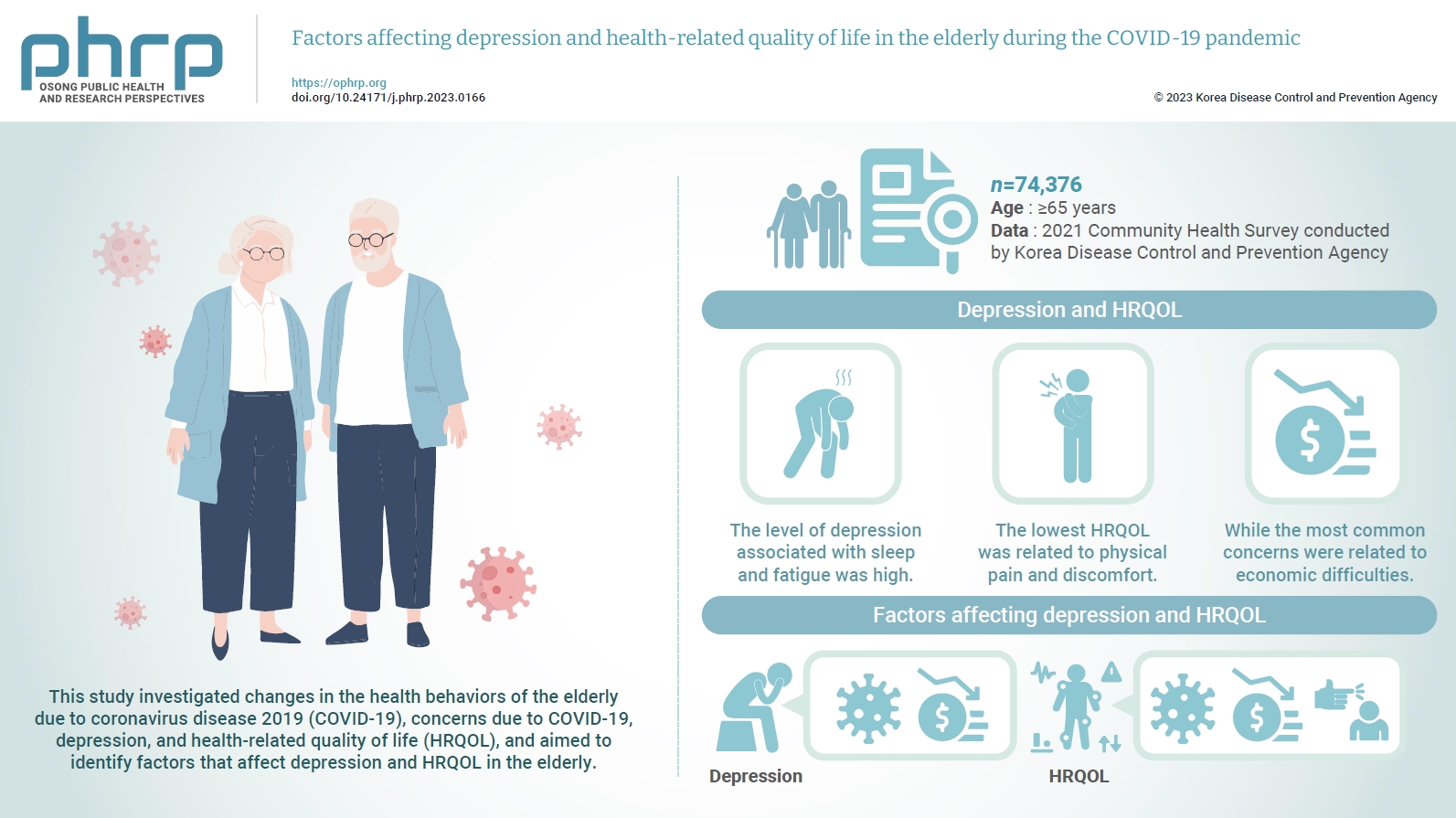
- Objectives
This study investigated changes in the health behaviors of the elderly due to coronavirus disease 2019 (COVID-19), concerns due to COVID-19, depression, and healthrelated quality of life (HRQOL), and aimed to identify factors that affect depression and HRQOL in the elderly. Methods: This study was conducted using data from the 2021 Community Health Survey of the Korea Disease Control and Prevention Agency. From a total sample size of 229,242 individuals, 74,376 elderly people aged 65 or older were selected as subjects, and changes in health behaviors, concerns due to COVID-19, depression, and HRQOL were measured and analyzed. Results: The level of depression associated with sleep and fatigue was high. The lowest HRQOL was related to physical pain and discomfort, while the most common concerns were related to economic difficulties. Factors influencing depression included worries about infection and economic harm, while factors impacting HRQOL encompassed concerns about infection, economic harm, and criticism from others. Conclusion: If an infectious disease situation such as COVID-19 reoccurs in the future, it will be necessary to encourage participation in hybrid online and offline programs at senior welfare centers. This should also extend to community counseling institutions like mental health welfare centers. Additionally, establishing connections with stable senior job projects can help to mitigate the effects of social interaction restrictions, physical and psychological health issues, and economic difficulties experienced by the elderly.
Corrigendum
- Correction to “The risk associated with psychiatric disturbances in patients with diabetes in Indonesia (2018): a cross-sectional observational study” [Osong Public Health Res Perspect 2023;14(5):368–78]
- Siti Isfandari, Betty Roosihermiatie, Sulistyowati Tuminah, Laurentia Konadi Mihardja
- Osong Public Health Res Perspect. 2023;14(6):530-531. Published online December 28, 2023
- DOI: https://doi.org/10.24171/j.phrp.2023.0144.e1
- Corrects: Osong Public Health Res Perspect 2023;14(5):368
- 371 View
- 14 Download




 First
First Prev
Prev


